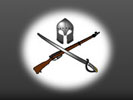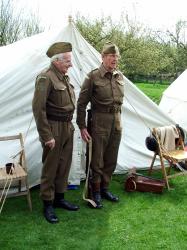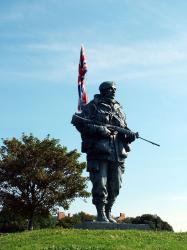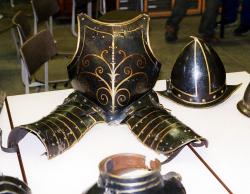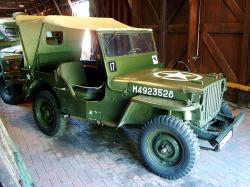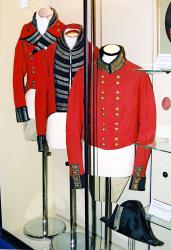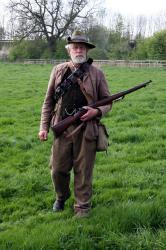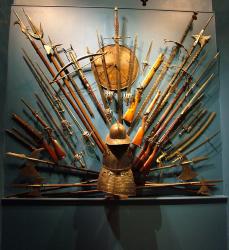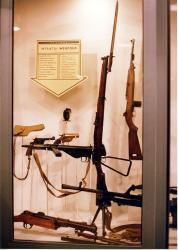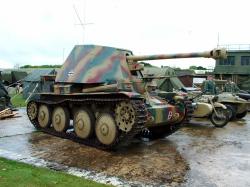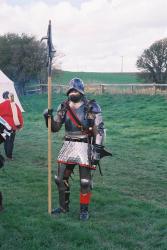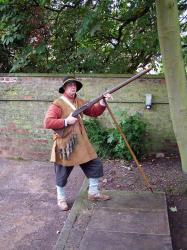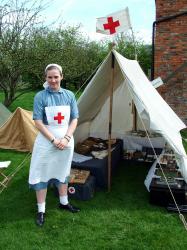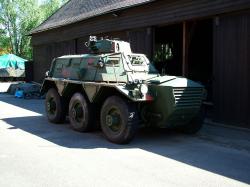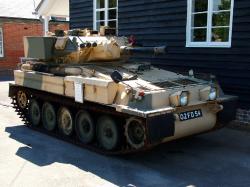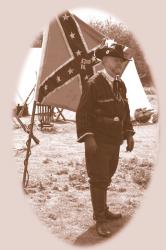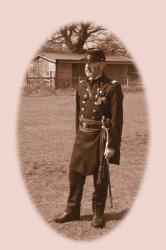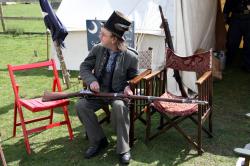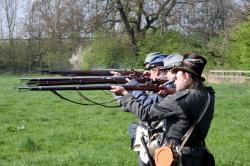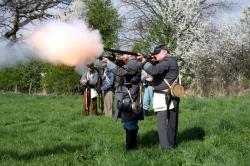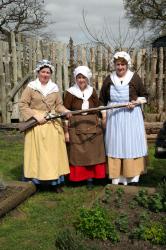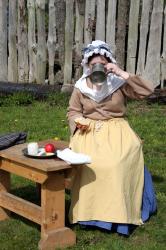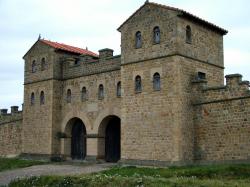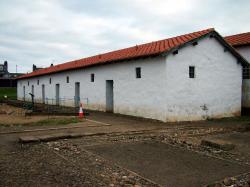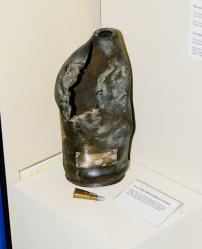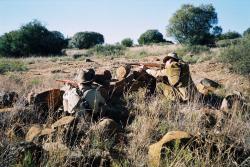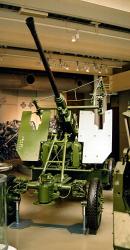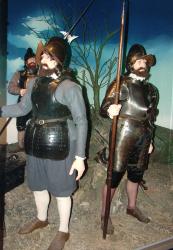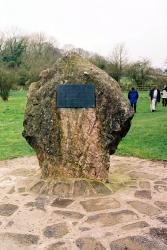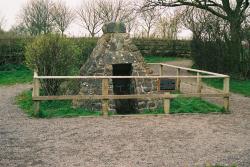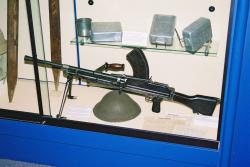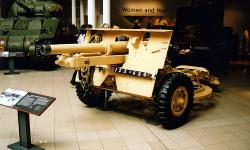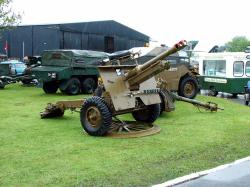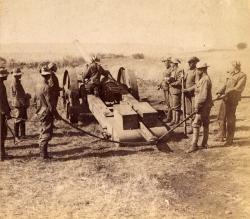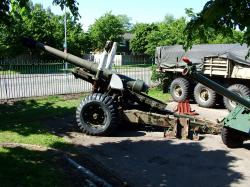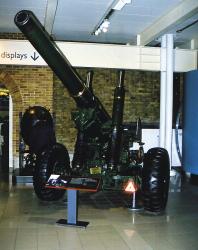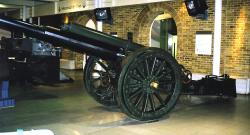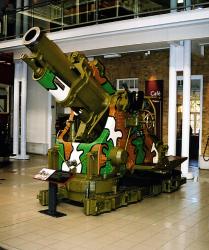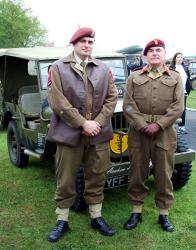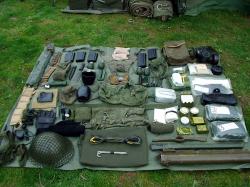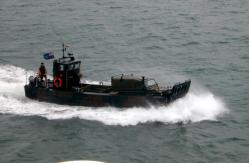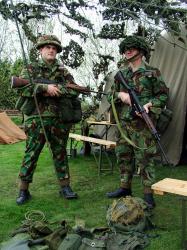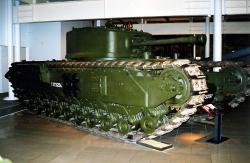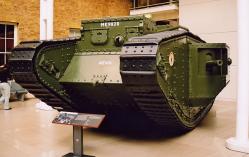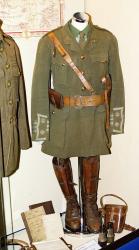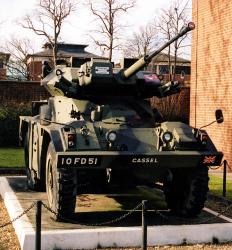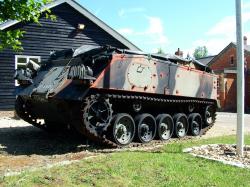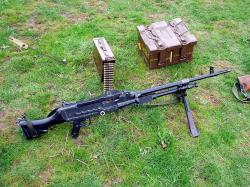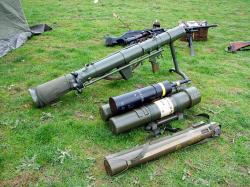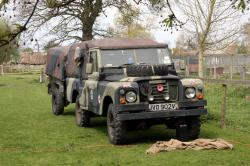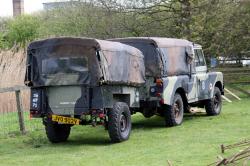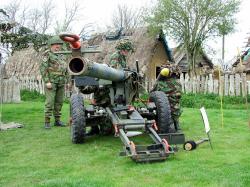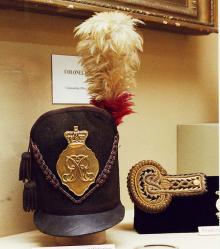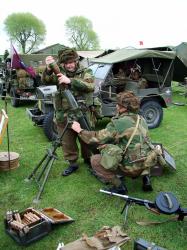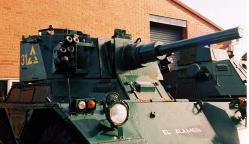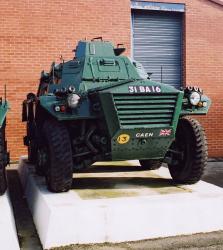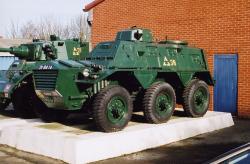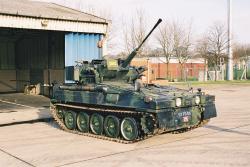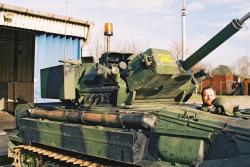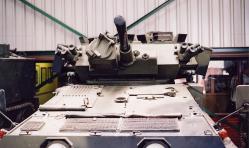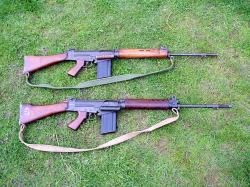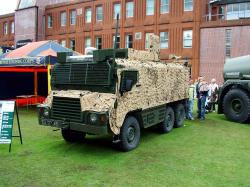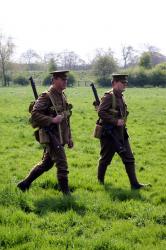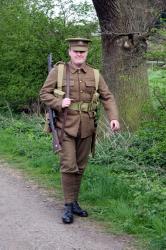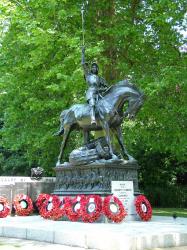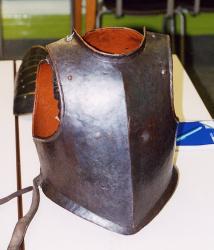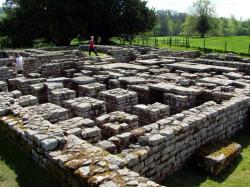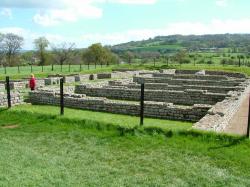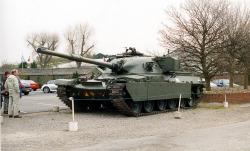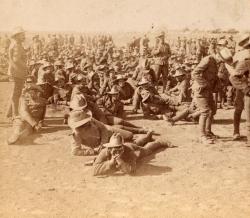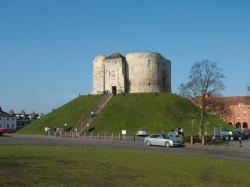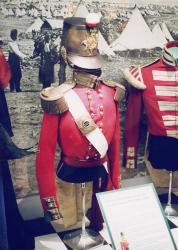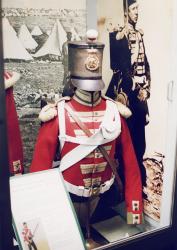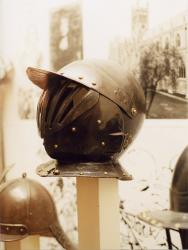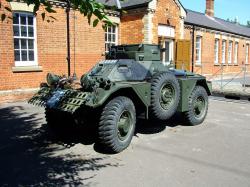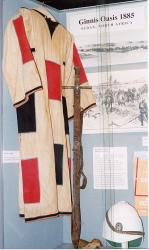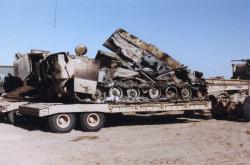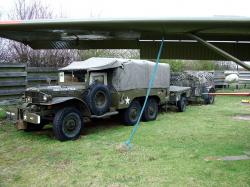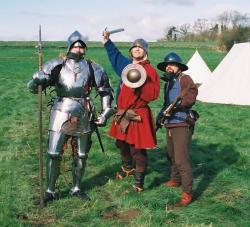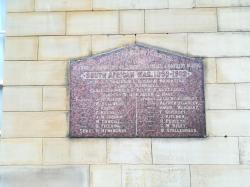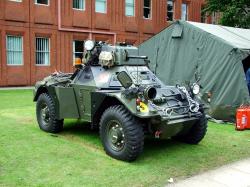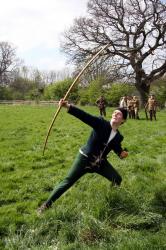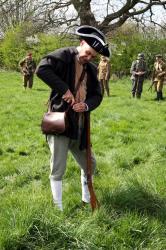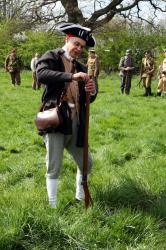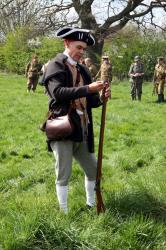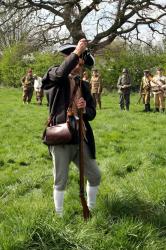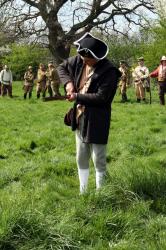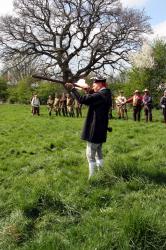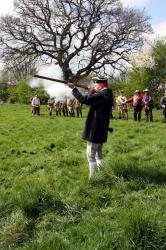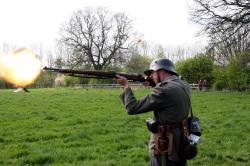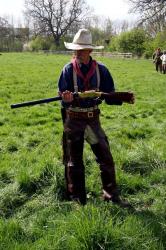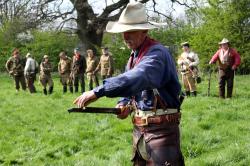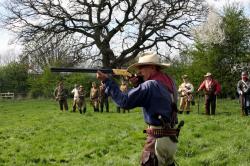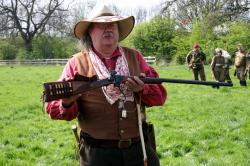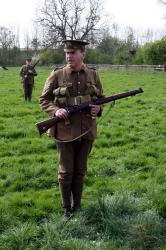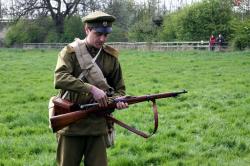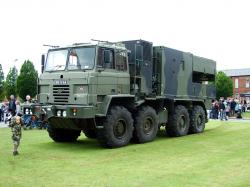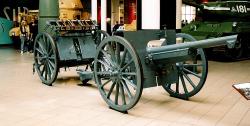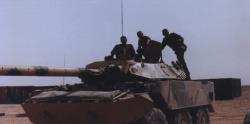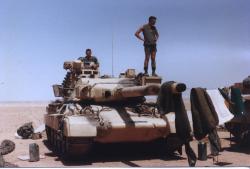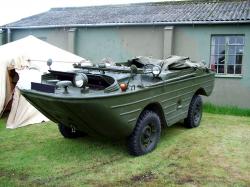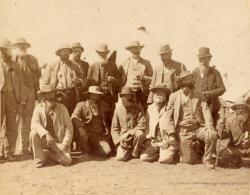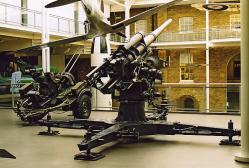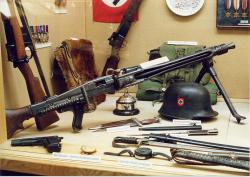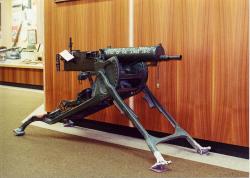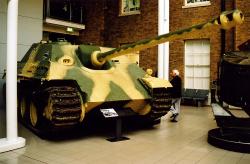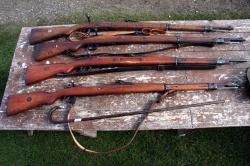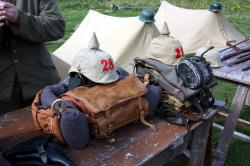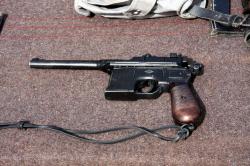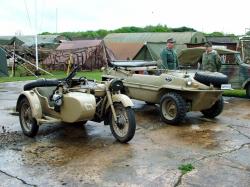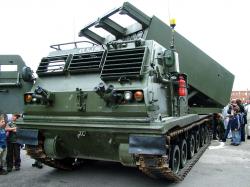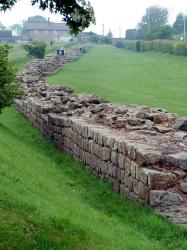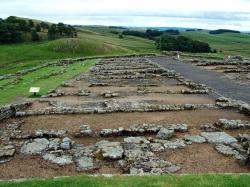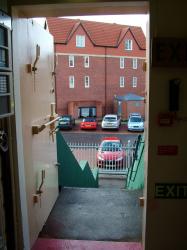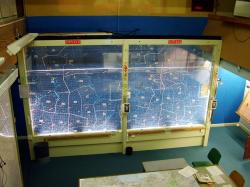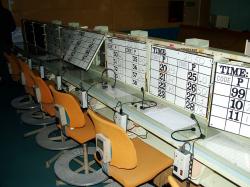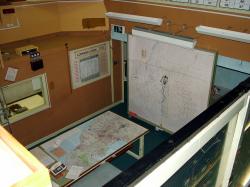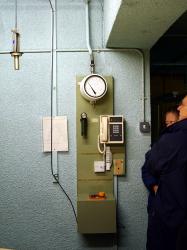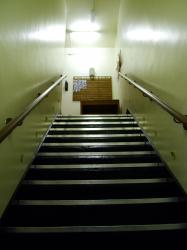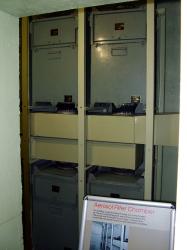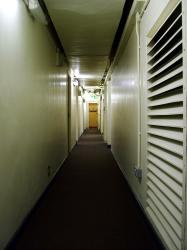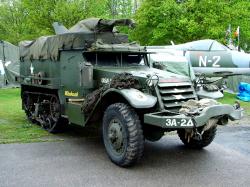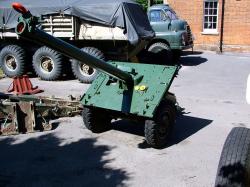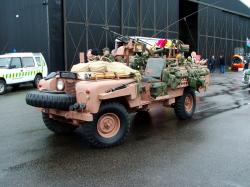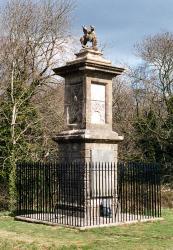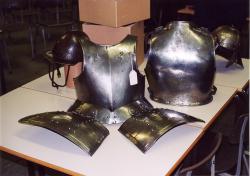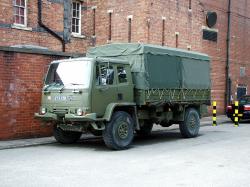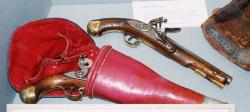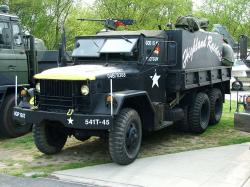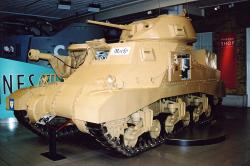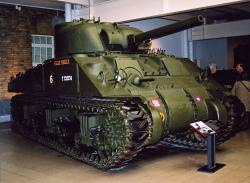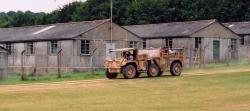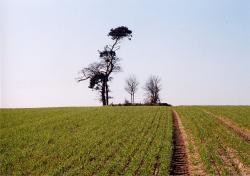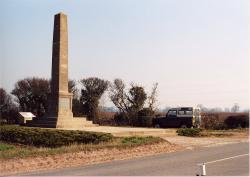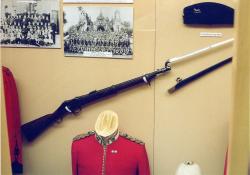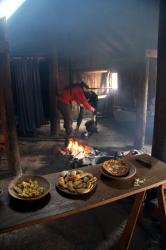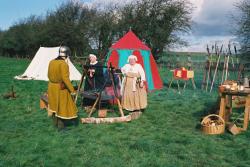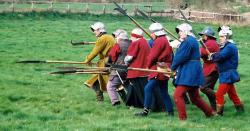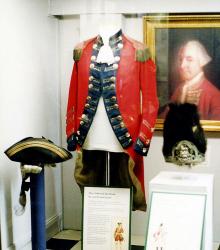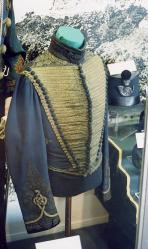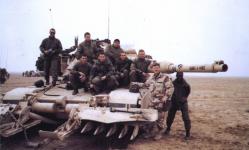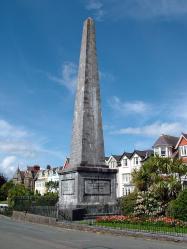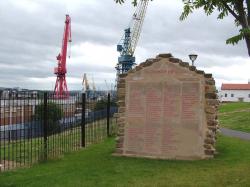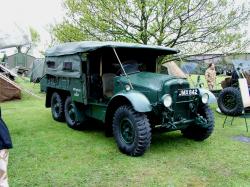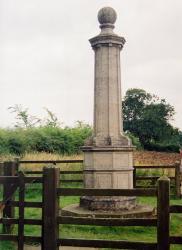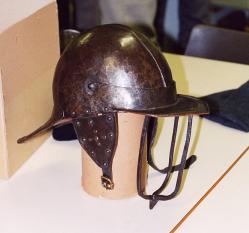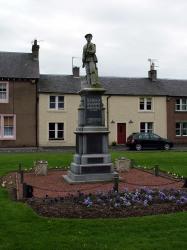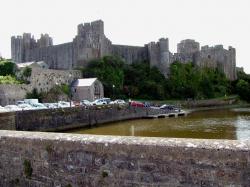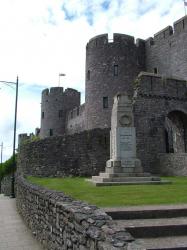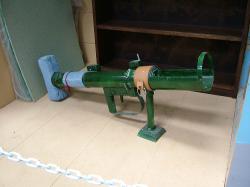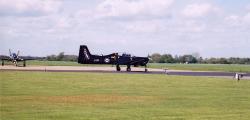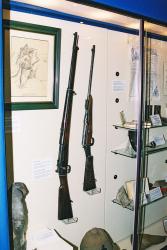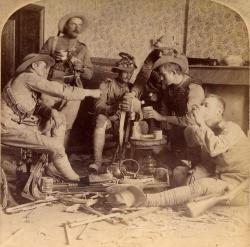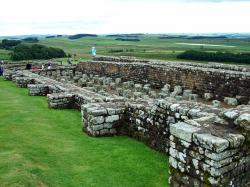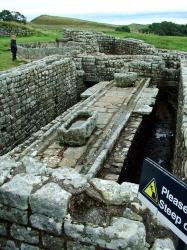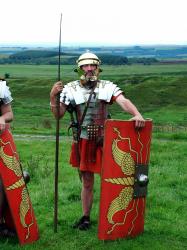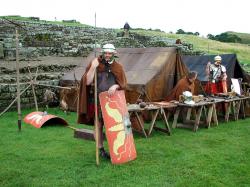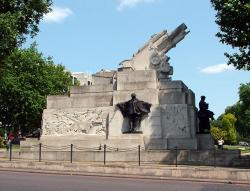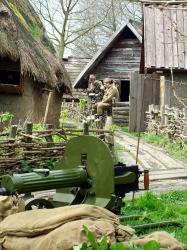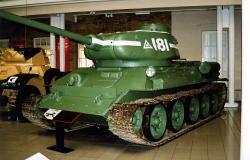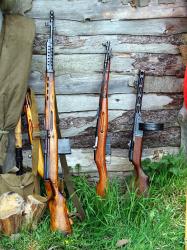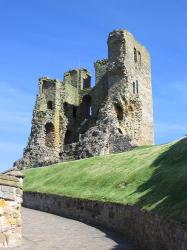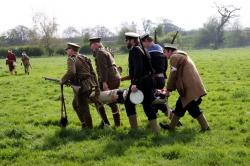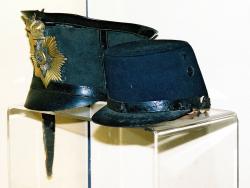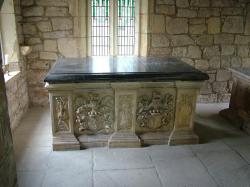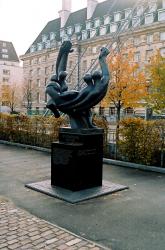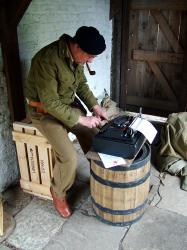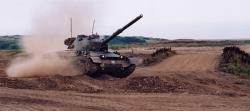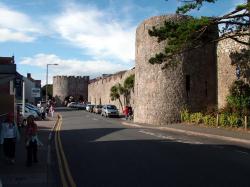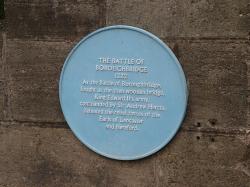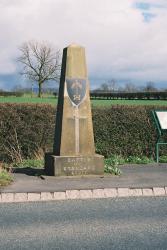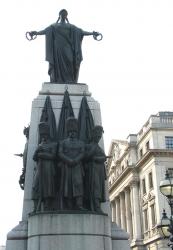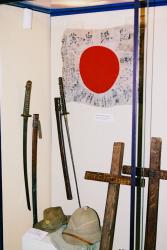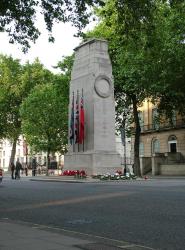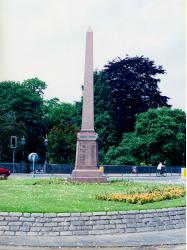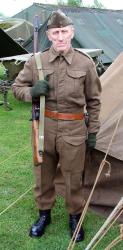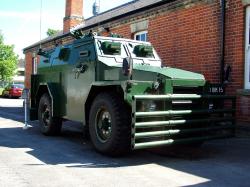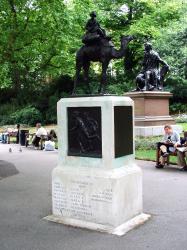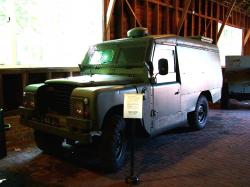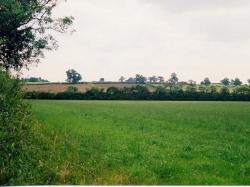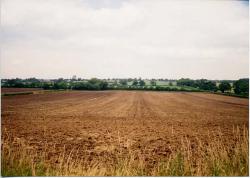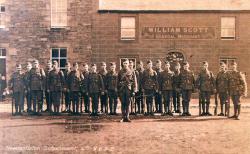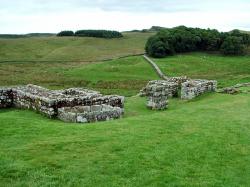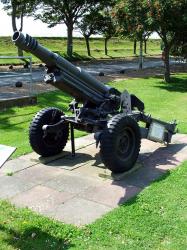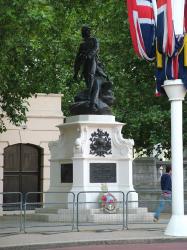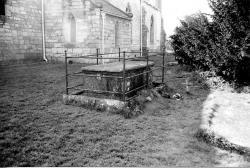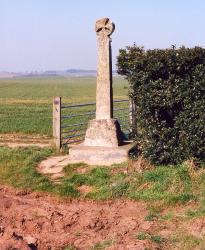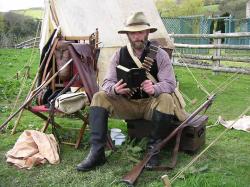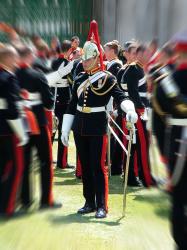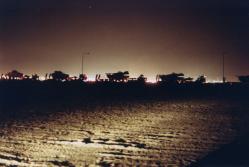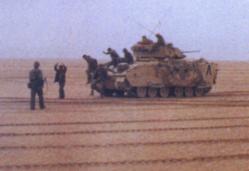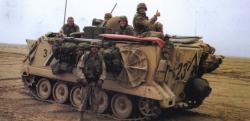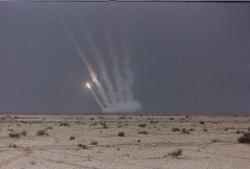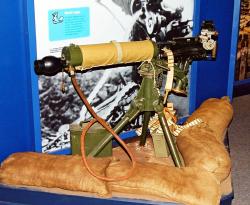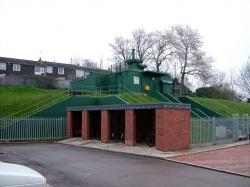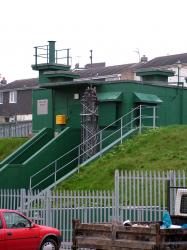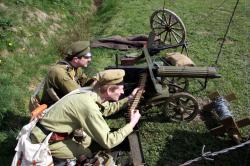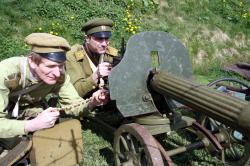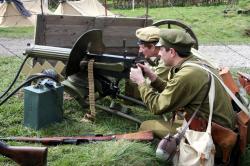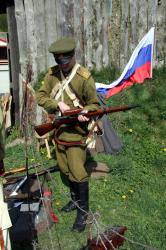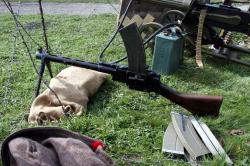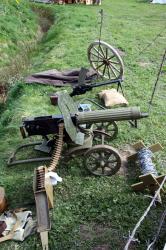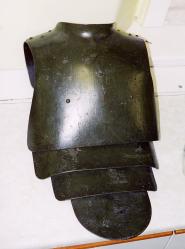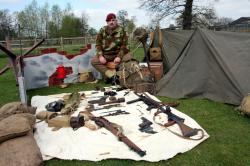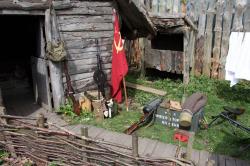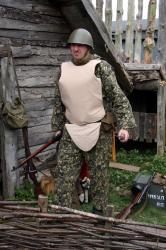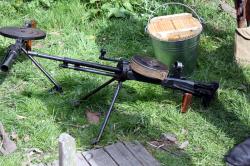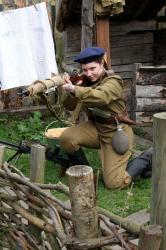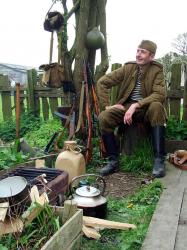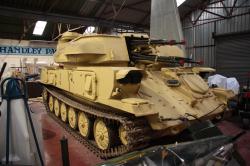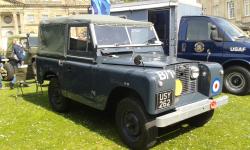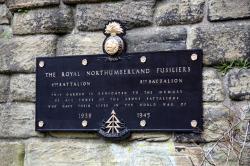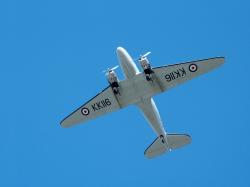Translate this Page
Recent images :
- International Harvester M5 halftrack
- Dassault Mystère Mk IVa number 146
- Ark Royal, Anti-ship missile defence gun.
- RAF Series 2 Land Rover
- Lightweight, air portable Land Rover
- Daimler Ferret Mk 1/2 Armoured Car
- RAF Mountain Rescue Series 3 Land Rover
- French Bronze 6 pounder cannon
- Farsley South African War Memorial
- Farsley War memorial
Images relating to Land Warfare
Click on the entry for a larger image and details, or click to go back to the previous index
Members of the 'Mainwarinings Mob' re-enactment group who recreate a unit of the British Home Guard during WW2. Although too old to join regular units and some have argued of potentially limited value during an actual invasion, they were of great mor...
History at Murton - Murton Park, York, England. April 2008
The statue outside the former Royal Marines Eastney barracks near Portsmouth dedicated to those who fought in the Falklands War 1982. It is based on an iconic photograph of a Marine 'yomping' or travelling cross-country from the landing point in San ...
Royal Marines Museum, Eastney, Southsea nr Portsmouth, England. 2007
Another image from Underwood and Underwood (from a stereoview) clearly showing the uniforms and equipment in use by the British troops during the Anglo-Boer War. It is entitled "Her Majesty's Heroes marching into Colesberg, S.A. after the Boers retre...
South Africa 1901
Flambouyant armour from Italy during the 1500's. The painting is not original.
Taken at the York Castle Museum, York, England, 2003
This particular example was used by General Sir Brian Horrocks, one of the British commanders of XXX Corps during Operation Market Garden
Aldershot Military Museum, Hampshire, England, May 2007
A set of Coatees and Infantry officer's hat as used by the 96th Regiment. From left to right they date from 1796-1816, a short-tailed coat from 1812, and 1829-54.
The Museum of Manchester's Regiment, Ashton-under-Lyne, UK. March 2004
Shown here are a pair of muskets used by the 96th Regiment during the 19th Century. On the left is the classic 'Brown Bess' smooth-bore flintlock musket used by the British in various forms from the 1720's into the 1840's. It had a .75inch calibre. O...
The Museum of Manchester's Regiment, Ashton-under-Lyne, UK. March 2004
A member of the Heilbron Commando Boer re-enactment group with Mauser and bandoliers.
History at Murton 3 - Murton Park, York, England. April 2009
A elegant display of arrayed weaponry from medieval polearms and 2-handed swords through to 19th century percussion muskets and carbines. There are rapiers, basket-hilt broadswords, bayonets, halberds and a crossbow arranged around a 17th century (En...
Taken at the York Castle Museum, York, England, 2005
A display of infantry weapons used during World War II. From the left the weapons areas follows:
- The wooden stock sub-machine gun at the bottom is an elderly German Bergman MP18 dating back to WW1 (but used in WW2).
- The pistol with lanyard ...
Taken at the York Castle Museum, York, England, 2003
This Marder III Ausf-H is run by the 21st Panzer Division re-enactment group ans is depicted in the desert colours of the Afrika Korps of 1943. It was armed with a 75mm PaK 40/3 anti-tank gun and a Czech 7.92 MG37 machine-gun in the front hull.
The ...
The Wheels and Wings 2006 event, Yorkshire Air Museum, York, UK. May 2006.
This man-at-arms wears quite an exotic suit of full armour of 15th century style and is armed with a bill polearm. Member of the Black Guard re-enactment group.
Palm Sunday Battlefield event, Towton, North Yorkshire, 2004
This image shows a German Panzergrenadier in traffic control, equiped with a Schmeisser MP-40 Submachine Gun and dressed in foul-weather uniform with his gas mask canister across his chest. He is a member of the 21st Panzer Division re-enactment grou...
The Wheels and Wings 2006 event, Yorkshire Air Museum, York, UK. May 2006.
A member of the Tower Hamlets Trayned Band showing how a Civil War musketeer would have been armed. He has a matchlock musket of the period, with a rest, and the match (a piece of slow-burning fuse used to light the priming powder which in turn ignit...
Mill Mount, York, England. September 2004
A depiction of a Red Cross aid post by members of the Joint War Organisation. The post is shown with nurse, tent and all necessary medical equipment and supplies.
History at Murton - Murton Park, York, England. April 2008
Two depictions of the kind of living quarters that soldiers would have had in two periods in Aldershot's life. One shows the barracks during the Victorian period, the other during the 1950's.
Aldershot Military Museum, Hampshire, England, May 2007
Protected by aluminium armour and mounting a 76mm main gun.
Aldershot Military Museum, Hampshire, England, May 2007
A recreation of a Southern irregular in the American Civil War
History at Murton 3 - Murton Park, York, England. April 2009
A recreation of a Union officer in the American Civil War
History at Murton 3 - Murton Park, York, England. April 2009
A medic of the 2nd South Carolina regiment
History at Murton 3 - Murton Park, York, England. April 2009
A sharpshooter of the 2nd South Carolina regiment cleans his rifled musket
History at Murton 3 - Murton Park, York, England. April 2009
A volley of fire from a group of ACW re-enactors
History at Murton 3 - Murton Park, York, England. April 2009
A volley of fire from a group of ACW re-enactors
History at Murton 3 - Murton Park, York, England. April 2009
Members of the Trainblazers re-enactment society portraying loyalists of the 1770s. A loyalist armed with a flintlock musket of the time.
History at Murton 3 - Murton Park, York, England. April 2009
Members of the Trainblazers re-enactment society portraying loyalists of the 1770s
History at Murton 3 - Murton Park, York, England. April 2009
Members of the Trainblazers re-enactment society portraying loyalists of the 1770s
History at Murton 3 - Murton Park, York, England. April 2009
A excellent reconstruction of the imposing 2 passage gatehouse which might once have stood on that spot at Arbeia Roman Fort
Arbeia Roman Fort, South Shields, Tyne and Wear, UK. October 2007
A reconstruction of a century barracks with separate rooms for each contubernuim of the century with a larger room at the end for the Centurion.
Arbeia Roman Fort, South Shields, Tyne and Wear, UK. October 2007
A view from the veranda of the reconstructed Commanders House at Arbeia
Arbeia Roman Fort, South Shields, Tyne and Wear, UK. October 2007
A view from the top of the reconstructed gatehouse of the plan of part of the fort which has been excavated. The large granaries which Arbeia was re-modeled to house as it's primary function can be seen in the foreground and to the upper right. The P...
Arbeia Roman Fort, South Shields, Tyne and Wear, UK. October 2007
A view of the hill itself from the track (now a road) in the vale between Lansdown Hill and Freezing Hill where the Royalists initially formed up. The woods to the right and left of the crest of the hill were there at the time, and Waller formed a de...
Lansdown Hill battlefield, near Bath, England. March 2003
A view south from the centre of the battlefield looking at the plateau at the top of the hill. This is where Waller and the Parliamentarians fell back to form a second line after the ferocious initial assult of the Cornishmen.
Lansdown Hill battlefield, near Bath, England. March 2003
A 94 pound shell from one of the Boer 'Long Tom' Creusot artillery pieces fired into the town of Ladysmith during it's seige. It presumably failed to explode. Also shown are a couple of rounds of Boer ammunition. The Manchesters Regiment were besiege...
The Museum of Manchester's Regiment, Ashton-under-Lyne, UK. March 2004
A member of the Heilbron Commando depicting a Boer fighter standing guard over the camp.
He is shown carrying the Mauser rifle and bandolier typical of the time.
History at Murton - Murton Park, York, England. April 2008
A Boer Mauser pistol taken by the East Yorkshire Rgt after Bothaville, November 1900
The Regimental Museum of the Royal Dragoon Guards & The Prince of Wales Own Regiment of Yorkshire. 2
Images of one of the un-sung heroines of the Anglo-Boer War - the steadfast Boer wives who provided for the fighters in the line and who, ultimately, were so poorly treated by the British policy of concentration camps (not to be confused with the lat...
History at Murton - Murton Park, York, England. April 2008
An excellent photograph of two members of the Oranje Vrijstaat Artillerie Corps blending with the veldt. It can readily be imagined how difficult these sharpshooters with smokeless cartridges would have been to target and hit. Their rifles appear to ...
South Africa, Jan 2005
The 40mm L/60 automatic anti-aircraft gun was designed in Sweden by Bofors in 1928. It became so successful it was simply known as a 'Bofors gun' and in various guises has been used by many armed forces up to the present. This particular example date...
Imperial War Museum, London, England. October 2003.
Two examples of the types of armour and weapons as used by the Reivers - cross Anglo-Scottish border warriors - during the 16th century.
The model on the left wears a simple back and breast armour with lower abdomen protection more common in pikemen...
Taken at the York Castle Museum, York, England, 2005
A monument on the Bosworth Battlefield placed to commemorate the fall of King Richard III during the battle. Although it indicates that it is placed on the spot where he fell, current research indicates that the actual site of the battle was some mil...
Bosworth Battlefield Visitor Centre and Country Park, Warwickshire, UK. March 2004
A Victorian pyramid built over a spring where, legend has it, King Richard III slaked his thirst during the battle of Bosworth.
Bosworth Battlefield Visitor Centre and Country Park, Warwickshire, UK. March 2004
The main LMG used by the British during World War 2, this is a Bren mark II from 1942.
The Museum of Manchester's Regiment, Ashton-under-Lyne, UK. March 2004
This British field gun was introduced in 1904 and was primarily used during World War 1. It could fire an 8.4kg shell up to 5965 metres and had a calibre of 84mm.
Imperial War Museum, London, England. October 2003.
The 25lbr Mk II QF gun was the standard British divisional field gun from the 1940's up to the late 1960's. It could be used in both the close support and anti-tank roles. The large wheel-like disk mounted horizontally under the body of the carriage ...
Imperial War Museum, London, England. October 2003.
These images show a 25 pounder gun with it's tractor, the Morris C8 Field Artillery Tractor (FAT) known as the Quad in WW2 colours. The Morris Quad was based on a pre-war 4x4 and continued inservice along with the 25lbr through the Second World War a...
The Wheels and Wings 2006 event, Yorkshire Air Museum, York, UK. May 2006.
A view of one of the huge, converted Naval pieces used as artillery in the Anglo-Boer war. It is from an Underwood and Underwood stereoview and is entitled "Sighting one of the 4.7 Naval Guns on the Boer Position at Schwartzkop, S.A."
South Africa 1900
A medium cailbre artillery piece brought into service in 1941 (this one dates from 1942) was still being used in the 1970's. It could fire a 45.4 kg shell up to a range of 14,810 metres or more than 9.2 miles.
Imperial War Museum, London, England. October 2003.
Medium artillery piece brought into service in 1904 and used extensively during World War 1 both on the Western front and in the Middle East. It's use declined during the Second World War. It had a 127mm calibre, 27.2 kg shell and a range of 12,700 m...
Imperial War Museum, London, England. October 2003.
A heavy seige howitzer from the First World War. This piece came into service in 1914 and it's incredible 290lb (131.5kg) shells would pound indirect targets up to 5.7 miles (9200metres) away. This kind of heavy artillery barrage became iconic of bat...
Imperial War Museum, London, England. October 2003.
Two members of the Normandy Arnhem Society portraying officers of the 9th Airborne Field Company, Royal Engineers during Operation Market Garden - the paratroop attack on Arnhem in the Netherlands in 1944. They are pictured in front of their Willy's ...
The Wheels and Wings 2006 event, Yorkshire Air Museum, York, UK. May 2006.
A display of the equipment as carried by the soldiers and marines who fought in the Falklands War, 1982.
It includes all his webing, spare clothing, bergen, washing & cleaning gear, rations & cooking equipment, sleeping bag, NBC suit plus respirat...
History at Murton - Murton Park, York, England. April 2008
This LCVP (Landing Craft Vehicle Personnel), from 17 Royal Logistics Corps Port and Maritime Regiment can transport a platoon of Soldiers or, as in this case, a Landrover and trailer and deliver them to a landing beach via the bow ramp.
Portsmouth Naval Dockyard, July 2003
A selection of re-enactors representing the British Army of the Rhine during the 1970's. They are dressed and equiped for the period in British DPM camouflage, '58 pattern webbing, puttees around the boots, and SLR L1A1 rifles (with the earlier woode...
History at Murton - Murton Park, York, England. April 2008
The Churchill was designed before the war and early, unreliable versions were rushed into service, proving disastrous. Between 1942 and 46 however they were improved and were used as heavy infantry support tanks in North Africa and Italy, then later ...
Imperial War Museum, London, England. October 2003.
This particular example was produced in 1918 and belonged to B Company, 4th Battalion Royal Tank Corps. It was armed with a 6lb'er gun on either side and four .303 inch Hotchkiss machine guns. It is similar to the type used in the battle of Cambrai, ...
Imperial War Museum, London, England. October 2003.
A pair of uniform items from the Manchesters Regiment during WW1. On the left is the officer's tunic, Sam Browne belt and boots of Lt.Col. Davies-Colley of the 2 Battalion, 6th Territorial Rgt of the Manchesters. On the right, in contrast, is the tun...
The Museum of Manchester's Regiment, Ashton-under-Lyne, UK. March 2004
An image of a Fox Combat Vehicle, Reconnaissance (Wheeled) or CVR(W) formerly in service with the Queens Own Yeomanry, a British Territorial Army or volunteer regiment but now serving as a gate guardian. It was equipped with a 30mm Rarden gun in it's...
Yorkshire Squadron, The Queens Own Yeomanry, Fulford Barracks, York. Feb' 2004
An image of a Fox Combat Vehicle, Reconnaissance (Wheeled) or CVR(W) formerly in service with the Queens Own Yeomanry, a British Territorial Army or volunteer regiment but now serving as a gate guardian. It was equipped with a 30mm Rarden gun in it's...
Yorkshire Squadron, The Queens Own Yeomanry, Fulford Barracks, York. Feb' 2004
The main light machine gun used by the British army since the 1960's. A 7.62mm, belt-fed workhorse that can lay down a heavy supporting fire from an infantry platoon or mounted on vehicles.
Displayed by the Forces80 re-enactment group.
History at Murton - Murton Park, York, England. April 2008
A British Grenadier's Cap dated 1786
The Regimental Museum of the Royal Dragoon Guards & The Prince of Wales Own Regiment of Yorkshire. 2
A display of 2 light anti-armour weapons used by the British Army in the 1970's and 80's.
The larger of the two is the Carl-Gustav 84mm recoilless rifle shown sitting on it's bipod mount. Also shown are examples of it's armour-piercing rounds.
...
History at Murton - Murton Park, York, England. April 2008
The classic British 4x4 of the 1970s with Sankey trailor
History at Murton 3 - Murton Park, York, England. April 2009
The classic British 4x4 of the 1970s with Sankey trailor
History at Murton 3 - Murton Park, York, England. April 2009
An artillery piece looked after by members of the 20th Century Revisited group. It was a prominent infantry fire support weapon from the 1960's.
It was a 120mm recoilless rifle and had a range of between 800 and 1000 yards. It fired a HESH round w...
History at Murton - Murton Park, York, England. April 2008
A re-creation of a crew of British Army personnel working a Mobat recoilless anti-tank weapon of the 1970's.
Crew'ed by members of the 20th Century Revisited group.
History at Murton - Murton Park, York, England. April 2008
An British Officer's Shako and epaulette from the 14th Regiment worn at the Battle of Waterloo
The Regimental Museum of the Royal Dragoon Guards & The Prince of Wales Own Regiment of Yorkshire. 2
Re-enactors from the Victory in Europe Re-enactment Association (VERA) as a paratroop heavy weapons platoon in action in north-west Europe, 1944. They portray soldiers of the 1st Battallion, The Border Regt. And are demonstrating how a crew would adj...
The Wheels and Wings 2006 event, Yorkshire Air Museum, York, UK. May 2006.
This 6 wheel drive armoured car was produced by Alvis Ltd during the 1960's and served with British forces into the 1970's. It had a top speed of 45mph (72km/h) but had good cross-country performance from it 6 wheel design and could function capably ...
Yorkshire Squadron, The Queens Own Yeomanry, Fulford Barracks, York. Feb' 2004
This 6 wheel drive armoured car was produced by Alvis Ltd during the 1960's and served with British forces into the 1970's. It had a top speed of 45mph (72km/h) but had good cross-country performance from it 6 wheel design and could function capably ...
Yorkshire Squadron, The Queens Own Yeomanry, Fulford Barracks, York. Feb' 2004
Built on the same basic chassis as the Saladin Armoured Car (see entry), this 6 wheel drive APC was designed in 1952 and has served with the British army until the 1990's, latterly in an urban role in Northern Ireland, and with many other countries u...
Yorkshire Squadron, The Queens Own Yeomanry, Fulford Barracks, York. Feb' 2004
Built on the same basic chassis as the Saladin Armoured Car (see entry), this 6 wheel drive APC was designed in 1952 and has served with the British army until the 1990's, latterly in an urban role in Northern Ireland, and with many other countries u...
Yorkshire Squadron, The Queens Own Yeomanry, Fulford Barracks, York. Feb' 2004
The current vehicle used by the Queens Own Yeomanry, although this particular vehicle is on loan from the Guards, the Scimitar is a variant of the Scorpion class of Combat Vehicle, Reconaissance (Tracked) mounting a 30mm Rarden Cannon for defence rat...
Yorkshire Squadron, The Queens Own Yeomanry, Fulford Barracks, York. Feb' 2004
A close-up view of the turret of the Scimitar (see other entry for details) showing the targeting equipment and smoke grenade launchers, as well as the exhaust for the new Cummins powerplant and the side stowage containers just above the tracks.
Yorkshire Squadron, The Queens Own Yeomanry, Fulford Barracks, York. Feb' 2004
This head-on view of the British Scorpion light tank or Combat Vehicle, Reconnaissance (Tracked) shows clearly it's sloped aluminium armour and 76mm main gun. It has a crew of 3 and with it's original Jaguar engine could reach 55mph.
The Muckleburgh Collection, Norfolk, England, Summer 2003.
A pair of British SLR rifles as used by the British Army during the 1970's and 80's.
They were a 7.62mm semi-automatic, single shot version of the Belgian FN Assault rifle.
Displayed by the 20th Century Revisited group.
History at Murton - Murton Park, York, England. April 2008
A depiction of the uniform and equipment of the British soldier during the 2nd Anglo-boer war 1899-1902.
Member of the Heilbron Commando re-enactment group
History at Murton - Murton Park, York, England. April 2008
A soldier of the Anglo-Boer war puts his kit on ready for action.
History at Murton 3 - Murton Park, York, England. April 2009
A new vehicle entering service with the British Army as a patrol vehicle and convoy escort. It has better armour and protection than a snatch landrover but is more manouverable and less intimidating than a tracked APC. The photographer was also told ...
Army in Yorkshire event, Imphal Barracks, York, UK. July 2008
Re-enactors of the Manchester Regiment portray Tommy Atkins with his kit and equipment
History at Murton 3 - Murton Park, York, England. April 2009
Re-enactors of the Manchester Regiment portray Tommy Atkins with his kit and equipment
History at Murton 3 - Murton Park, York, England. April 2009
Re-enactors of the Manchester Regiment portray Tommy Atkins with his kit and equipment
History at Murton 3 - Murton Park, York, England. April 2009
A monument erected to the 'Cavalry of the Empire', regiments commemorating those who fell from those regiments in both world wars. Features a triumphant St George, sword upraised over the vanquished dragon. The low wall behind the statue lists the re...
Hyde Park, London, England. June 2005
This English breastplate and backplate from the mid 17th century illustrates the basic protection considered necessary for a soldier of horse of this period. The breastplate is musket-proof (see the small dent or proof mark just the the right of cent...
Taken at the York Castle Museum, York, England, 2003
A close-up of the beautifully preserved hypocaust or under-floor heating supports from the main Commandants house or Praetorium at Chesters. A furnace, tended by a slave, would have been built in the walls with chimneys directing hot air around these...
Chesters Roman Fort, near Hexham, Northumberland. May 2005.
The remains of the eastern gate of the fort at Chesters
Chesters Roman Fort, near Hexham, Northumberland. May 2005.
The best preserved set of Roman 2nd century cavalry barracks on Hadrians wall can be seen at Chesters. Here the row of mess rooms can be seen, which faced a matching set across a paved street and fronted by a veranda. The officers quarters would have...
Chesters Roman Fort, near Hexham, Northumberland. May 2005.
An unusual prototype of this British battle tank of the 1960's mounting a 120mm gun
Yorkshire Air Museum, Elvington, York, England. Easter 2003
A photograph by Underwood and Underwood entitled "City of London Imperial Volunteers just arrived at the Orange River, South Africa." showing another of the different types of uniform worn by British forces in 1900.
South Africa 1900
Stacked rifles and the southern battleflag in front of a tent of the 32nd Virginia Regiment
History at Murton 3 - Murton Park, York, England. April 2009
A intersting example of a motte and bailey castle, the mound being the remains of a wooden castle built by William I around 1068 with the four-lobed stone keep replacing the wooden structure in the 13th Century. It has a commanding view of the Vale o...
Tower Street, York,UK. March 2005 & March 2006.
The uniform of an officer in the 19th foot during the Crimea, 1854-56.
The Regimental Museum of the Green Howards, Richmond, North Yorkshire. April 2003.
A rare surviving example of an infantry soldier's uniform, marching order, from the time of the Crimean War from the 19th foot (The Green Howards)
The Regimental Museum of the Green Howards, Richmond, North Yorkshire. April 2003.
A pair of full-face close helmets worn by cuirassiers during the English Civil War. The helmets would be part of an all-over plate armour similar to the later medieval knights except that the leg armour tended to be fully articulated and ended at the...
Taken at the York Castle Museum, York, England, 2003
In Middle East desert colour scheme.
Yorkshire MVT event, York, April 2017
A Jibbah (Patched smock) and sword captured from the warriors of the Mahdi in the Sudan after the Battle of Ginnis, 30 Dec 1885. Also shown is the type of helmet worn by the British soldiers at the time.
The Regimental Museum of the Green Howards, Richmond, North Yorkshire. April 2003.
The wreckage of two US Bradley AFV's of the 2nd Armoured Cavalry Regiment, knocked out during operation Desert Storm, in the 1st Coalition's war against Iraq to liberate Kuwait.
The Iraq/Kuwait desert, 1991
Awaiting further details.
Midlands Aircraft Museum, Coventry Airport, Baginton,England. March '07 & March '08
A monument to the Duke of Wellington at Hyde Park, outside his former home, Apsley House. The memorial is surrounded by 4 figures depicting four regiments he was associated with during his military career.
Hyde Park, London, England. June 2005
A pikeman and a musketeer from the 17th century.
The pikeman in this picture actually holds a halberd, which would have been particularly effective against mounted opponents. He is also armed with a mortuary sword hanging to his left, and is protec...
Mill Mount, York, England. September 2004
Here are depicted three different types of foot soldier from the time of the battle of Towton, 1461. On the left, he is a fully armoured man-at-arms with battle axe. In the centre is a foot soldier in the livery of the House of York armed with sword ...
Palm Sunday Battlefield event, Towton, North Yorkshire, 2004
"...Erected by Fellow Villagers" - Lists the names of men of Farsley who died in the South African (2nd Boer) War, 1899 - 1902.
Farsley, West Yorkshire. Nov 2018
A lovely example of the Mark 2 Ferret displayed at the Imphal open day. Used in the 1960's, this one mounts a .30 calibre Browning MG.
Army in Yorkshire event, Imphal Barracks, York, UK. July 2008
An arrow is loosed from the bow of a member of the York City Levy
History at Murton 3 - Murton Park, York, England. April 2009
Loading and firing an American flintlock musket of the American War of Independance
History at Murton 3 - Murton Park, York, England. April 2009
Loading and firing an American flintlock musket of the American War of Independance
History at Murton 3 - Murton Park, York, England. April 2009
Loading and firing an American flintlock musket of the American War of Independance
History at Murton 3 - Murton Park, York, England. April 2009
Loading and firing an American flintlock musket of the American War of Independance
History at Murton 3 - Murton Park, York, England. April 2009
Loading and firing an American flintlock musket of the American War of Independance
History at Murton 3 - Murton Park, York, England. April 2009
Loading and firing an American flintlock musket of the American War of Independance
History at Murton 3 - Murton Park, York, England. April 2009
Loading and firing an American flintlock musket of the American War of Independance
History at Murton 3 - Murton Park, York, England. April 2009
Loading and firing an American flintlock musket of the American War of Independance
History at Murton 3 - Murton Park, York, England. April 2009
Loading and firing the Mauser G98 rifle used by the German Army from the 1890s right up to the 1940s
History at Murton 3 - Murton Park, York, England. April 2009
Loading and firing the lever-action Henry rifle popular in the America of the 1860s incuding the wild west and the American Civil War
History at Murton 3 - Murton Park, York, England. April 2009
Loading and firing the lever-action Henry rifle popular in the America of the 1860s incuding the wild west and the American Civil War
History at Murton 3 - Murton Park, York, England. April 2009
Loading and firing the lever-action Henry rifle popular in the America of the 1860s incuding the wild west and the American Civil War
History at Murton 3 - Murton Park, York, England. April 2009
Loading and firing the lever-action Henry rifle popular in the America of the 1860s incuding the wild west and the American Civil War
History at Murton 3 - Murton Park, York, England. April 2009
The dropping block single shot Sharps Carbine popular in the America of the 1860s for buffalo hunting
History at Murton 3 - Murton Park, York, England. April 2009
One of the most successful weapons of its time - the .303 inch SMLE was iconic of the British soldier of WW1
History at Murton 3 - Murton Park, York, England. April 2009
Russian Mosin Nagant Carbine being demonstrated by a re-enactor of the Russian 13th Imperial Regiment
History at Murton 3 - Murton Park, York, England. April 2009
The main rifle of the Austro-Hungarian forces of the First World War, it was unusual in having a straight-pull bolt mechanism rather than the more usual rotating bolt.
History at Murton 3 - Murton Park, York, England. April 2009
A cheap and effective sub-machine gun issued to Allied special forces (as demonstrated here) during the Second World War. The Australian model had a vertical magazine rather than the usual horizontal configuration.
History at Murton 3 - Murton Park, York, England. April 2009
This collection of items from World War 1 illustrates the nature of life and war in the the trenches. Water bottles and a Very pistol for firing signal flares sit alongside items from the offensive side of trench warfare. From left to right, a trench...
The Museum of Manchester's Regiment, Ashton-under-Lyne, UK. March 2004
The Foden based Improved Medium Mobility Load Carrier mounting the Cobra radar array as used by the British Army for counter battery artillery location.
Army in Yorkshire event, Imphal Barracks, York, UK. July 2008
This important field gun was introduced in 1897 and was the standard French fieldpiece into the 1930's. It played an important role in the German defeat at Verdun in 1916 and could fire a 7.2kg shell a maximum of 6850 metres.
Imperial War Museum, London, England. October 2003.
An AMX 10 Light Tank of the French Foreign Legion, probably the 1st REC, as part of the Coalition forces against the Iraqi invasion of Kuwait. Note that this useful item of light armour is wheeled, rather than tracked for speed and durability on roa...
Iraqi/Kuwait desert, 1991
An AMX 30, crewed by French Foreign Legionaires showing the human side of war. Even in war, kit and equipment needs to be maintained, and gun barrels can double as good clothes lines. It is armed with a French-made 105mm main gun, and a 20mm GIAT can...
Iraqi/Kuwait desert, 1991
Several of the French cannon captured by the British at the Battle of Waterloo and brought to the Tower of London by the Duke of Wellington in 1815.
Tower of London, UK. Oct 2018
The GAZ 46 was inspired by US amphibious vehicles supplied to Russia during the War, but entered service in the 1950's an has been used by many easter-bloc allied forces since. It could carry up to 5 people, and due to it's steeply raked front and re...
The Wheels and Wings 2006 event, Yorkshire Air Museum, York, UK. May 2006.
A photograph entitled "Gen. Cronje's principle Commandants - surrendered to Lord Roberts, Feb 27th, S. Africa." showing a group of senior Boers reputedly taken by the British after Paardeberg. Currently I have no names to put to faces - anyone recogn...
South Africa 1900
The saddle and bridle of Boer General Piet Cronje, surrendered after the Battle of Paardeberg to the Alexandra, Princess of Wales' Yorkshire Regiment (The Green Howards), Feb 1900.
The Regimental Museum of the Green Howards, Richmond, North Yorkshire. April 2003.
The premier, multi-purpose gun of the second world war, the German 88 was respected and feared wherever it was encountered. A high muzzle velocity, good accuracy and penetrating ammunition, as well as plentiful production meant that this AA gun could...
Imperial War Museum, London, England. October 2003.
Various German artifacts from WW2 including an MG42 machine gun and infantry helmet.
The Regimental Museum of the Royal Dragoon Guards & The Prince of Wales Own Regiment of Yorkshire. 2
A German infantry machine-gun dated 1917
The Regimental Museum of the Royal Dragoon Guards & The Prince of Wales Own Regiment of Yorkshire. 2
This tank destroyer from 1943 was based on a Pzkpfw 5 Panther chassis and mounted a powerful 88mm anti-tank gun, the equal of almost all allied armour during the war. This particular example was knocked out in Belgium in 1944.
Imperial War Museum, London, England. October 2003.
Used on all fronts throughout the second world war the 5cm pak38 was the mainstay of the German infantry's anti-tank artillery. Designed in 1940 it fired a 2.2kg armour-piercing shell up to 2,650m range.
Imperial War Museum, London, England. October 2003.
Pack and weapons of the German Infantry Regiment nr.28 of 1914
History at Murton 3 - Murton Park, York, England. April 2009
Pack and weapons of the German Infantry Regiment nr.28 of 1914
History at Murton 3 - Murton Park, York, England. April 2009
Pack and weapons of the German Infantry Regiment nr.28 of 1914
History at Murton 3 - Murton Park, York, England. April 2009
A pair of vehicles maintained by the 21st Panzer Division re-enactment group. The first is a representation of a KS750 Zundapp Motorbike and side car mounting an MG 34 light machine gun in the sidecar. Zundapp produced around 18,000 of these agile, p...
The Wheels and Wings 2006 event, Yorkshire Air Museum, York, UK. May 2006.
The Royal Artillery's main long range weapon system capable of launching 12 guided rockets, each delivering a 200lb warhead up to 300 miles range.
Army in Yorkshire event, Imphal Barracks, York, UK. July 2008
The Roman wall which runs from Newcastle in the east to Carlisle in the west was not build to a consistent plan. Initially it was intended to build it all 3 metres (10 feet) wide but this plan was changed and most was built to a narrower design. This...
Heddon-on-the-Wall, Northumberland, UK. May 2008
An untitled photograph of a troop of horse artillery from the Anglo-Boer War period. The image clearly shows the late 19th century British khaki uniform.
From an Underwood and Underwood stereoview.
South Africa 1901?
An excavated infantry barracks, clearly showing the separate rooms which would have accomodated up to 8 soldiers.
Housteads Roman Fort, Northumberland, UK. August 2008
Views from a tour around the York Cold War Bunker
Acomb, near York, UK. Feb 2007
Views from a tour around the York Cold War Bunker
Acomb, near York, UK. Feb 2007
Views from a tour around the York Cold War Bunker
Acomb, near York, UK. Feb 2007
Views from a tour around the York Cold War Bunker
Acomb, near York, UK. Feb 2007
Views from a tour around the York Cold War Bunker
Acomb, near York, UK. Feb 2007
Views from a tour around the York Cold War Bunker
Acomb, near York, UK. Feb 2007
Views from a tour around the York Cold War Bunker
Acomb, near York, UK. Feb 2007
Views from a tour around the York Cold War Bunker
Acomb, near York, UK. Feb 2007
Views from a tour around the York Cold War Bunker
Acomb, near York, UK. Feb 2007
Views from a tour around the York Cold War Bunker
Acomb, near York, UK. Feb 2007
This halftrack produced during the war under the lend-lease agreement could carry 3 crew and a section of 10 infantrymen with a reasonable firepower. It has a .50 calibre machine gun on a ring mount above the crew compartment (unfortunately covered w...
The Wheels and Wings 2006 event, Yorkshire Air Museum, York, UK. May 2006.
Aldershot Military Museum, Hampshire, England, May 2007
An excellent example of the 'Pink Panther' style Land Rover as used by the SAS for desert reconnaissance and special operations. The superstructure has been pared to the bone, then covered in equipment!
The close-ups show the sort of kit carried, ...
The Wheels and Wings 2006 event, Yorkshire Air Museum, York, UK. May 2006.
A monument to the commander of the Cornish foot, Colonel Sir Bevile Grenvile, and the battle of Lansdown Hill (5th July 1643) positioned at the top of the hill (just off the present road) about the centre of the battlefield and approximately where he...
Lansdown Hill battlefield, near Bath, England. March 2003
A Pikeman's back and breastplate from around 1660 of the pattern used during the English Civil War. It also shows the hinged plates which would have covered the wearer's lower abdomen and upper leg area. Also the the left can be seen a Lobster helm a...
Taken at the York Castle Museum, York, England, 2003
This image shows several objects used by the Manchester's Regiment during the Malaysia campaign 1951-54. The main item is a specially designed Lee Enfield Carbine, 5 inches shorter than the standard rifle to be more effective in jungle warfare. It is...
The Museum of Manchester's Regiment, Ashton-under-Lyne, UK. March 2004
The army's current 'workhorse' 4 ton truck.
Army in Yorkshire event, Imphal Barracks, York, UK. July 2008
A pair of light dragoon flintlock pistols dated around 1790.
The Regimental Museum of the Green Howards, Richmond, North Yorkshire. April 2003.
A clean example showing radio aerial mountings
Yorkshire MVT event, York, April 2017
Developed during WW2 as a replacement for the out-gunned Stuart Light Tanks, it was designed ito carry a heavier 75mm gun to take on the German armour. Although it actually saw little service other than the the later stages of the war in NW Europe, i...
The Wheels and Wings 2006 event, Yorkshire Air Museum, York, UK. May 2006.
A Vietnam War era US M35 truck modified to represent one of the armoured gun trucks that would accompany and provide protection for convoys along the many contested roads between bases.
Wheels and Wings 2008, Yorkshire Air Museum, Elvington
This British version of an American tank was used in the North African desert campaigns of 1941 and fought at El Alamein. It was originally armed with a 75mm gun in the hull, and a 37mm gun in the turret which gave it a fighting chance against the Ge...
Imperial War Museum, London, England. October 2003.
Between 1942 and 1946, 40,000 of these important tanks were built, pouring much-needed Allied armour into the push against the previously indestructable German Panzers. This one is in the colours of the British Guards Armoured Division and was armed ...
Imperial War Museum, London, England. October 2003.
An unusual 6 wheel drive, roll-articulated vehicle designed in the US in the 1970's as an all-terrain transport. It is fully amphibious, and the joint in the middle allows the front and rear halves to pitch and roll up to around 40 degrees from each ...
The Muckleburgh Collection, Norfolk, England, Summer 2003.
A Maori axe taken by the 14th Regiment during the New Zealand campaigns 1860-66
The Regimental Museum of the Royal Dragoon Guards & The Prince of Wales Own Regiment of Yorkshire. 2
The view north towards the Royalist position from 'Cromwells Plump', the highest point on the ridge where the Parliamentarian forces formed before the Battle of Marston Moor. The Royalist line formed in front of the tree line just below the horizon. ...
Marston Moor, between Tockwith and Long Marston, North Yorkshire, England. March 2003
The view looking south and south-west from the left of the Royalist position at the ridge where the Parliamentarians formed. The battlefield monument can just be seen in the haze, and Cromwell's plump on the ridgeline.
Marston Moor, between Tockwith and Long Marston, North Yorkshire, England. March 2003
The small clump of trees at the highest point of the ridge where the Parliamentarian forces lined up before the Battle of Marston Moor. It is thought to be where the Commanders surveyed the Royalist forces to decide their battle plan. Even though Lor...
Marston Moor, between Tockwith and Long Marston, North Yorkshire, England. March 2003
The monument to the Battle of Marston Moor, on the Tockwith to Long Marston road.
Marston Moor, between Tockwith and Long Marston, North Yorkshire, England. March 2003
A Martini-Henry rifle and bayonet, circa 1880
The Regimental Museum of the Royal Dragoon Guards & The Prince of Wales Own Regiment of Yorkshire. 2
Members of the York City Levy prepare medival dishes.
History at Murton 3 - Murton Park, York, England. April 2009
Members of the York City Levy prepare medival dishes.
History at Murton 3 - Murton Park, York, England. April 2009
An example of the camp followers and how a military camp in the time of the Wars of the Roses might have looked. Polearms are racked ready for use, food is cooking over the fire and bread and cheese waits on the nearby table.
Palm Sunday Battlefield event, Towton, North Yorkshire, 2004
A demonstration by the Company of Palm Sunday group on how the bill polearm would have been used to provide a defensive wall against mounted knights and approaching foot.
Palm Sunday Battlefield event, Towton, North Yorkshire, 2004
A Jacket and tri-corn cap including wig from the 1740's. Also shown on the right is a grenadier's headdress from the 1760's.
The Regimental Museum of the Green Howards, Richmond, North Yorkshire. April 2003.
A Uniform jacket from the militia battalion of the 19th foot from the later 1800's.
The Regimental Museum of the Green Howards, Richmond, North Yorkshire. April 2003.
A good shot of a specialist mine clearance tank of the 2nd Armoured Cavalry Rgt. Taken after the Battle of 73rd Easting, some slight damage to the barrel shroud can be seen which was the result of a direct hit by a mortar round. The officer in the de...
Iraqi desert, 1991
This column, at the top of Picton Terrace in Carmarthen, Wales, was errected to commemorate General Sir Thomas Picton, (August, 1758 - June 18, 1815) who led the 'Fighting' 3rd Division of the Duke of Wellington's troops during the Penninsular War an...
Carmarthen, Wales. August 2004
A monument built at the eastern most end of Hadrians Wall at the fort and museum of Segedunum. It is based on names from Century stones found along the length of the wall recording the Centurions in charge of the work parties on the construction.
Segedunum, Wallsend, Tyne and Wear, England. June 2004
The Morris 6x4 Tractor was brought into service in the 1930's to tow heavy field guns like the 25 pounder but was not as manouverable as the later Morris Quad which replaced it. Many CDSW's were left on the beaches at Dunkirk after the evacuation and...
The Wheels and Wings 2006 event, Yorkshire Air Museum, York, UK. May 2006.
A commemorative monument errected on the battlefield just north of Cromwell's position on Red Hill Ridge.
Naseby, Northamptonshire, August 2001
This three-barred pott helmet was worn by an harquebusier, a more modern type of cavalryman armoured just with a buff coat, back and breastplate and this type of helmet. It became known as a 'lobster pott' due to the plated rear neck protector and th...
Taken at the York Castle Museum, York, England, 2003
The war memorial in the centre of the village square in a small border village dedicated "To the memory of the men of Liddesdale who gave their lives for thei country in the Great War 1914-1918 and whose names are inscribes here with reverence and gr...
Newcastleton, Roxburghshire, Scotland. April 2005
Two re-enactors of the 8./ Grenadier Regiment Grossdeutschland demonstrating an MG42 and its firing position with the no.2 feeding the belt ammunition int the breech.
The Wheels and Wings 2006 event, Yorkshire Air Museum, York, UK. May 2006.
The medieval castle of Pembroke. It was originally constructed at the beginning of the 13th century to replace an earlier wooden castle built by the Norman baron, Roger de Montgomery in 1093. It became the seat of the Earls of Pembroke and was the bi...
Pembrokeshire, Wales. August 2004
The war memorial outside the main entrance to Pembroke castle.
Pembrokeshire, Wales. August 2004
The Projector, Infantry, Anti Tank weapon or PIAT for short was used by British forces during and after World War 2, particularly by paratroopers when no other anti-tank guns were available for example at Arnhem and Pegasus Bridge. It had to be loade...
North East Aircraft Museum, Sunderland, England. October 2004.
This picture of a Tucano of No.72(R) Sqn taxiing to the hold on the main runway at Linton-on-Ouse prior to a training exercise vividly shows off the RAF's new training colour scheme. They have concluded that contrary to normal military aircraft, trai...
RAF Linton-on-Ouse, North Yorkshire, England. May 2004.
A pair of rifles from the 2nd Anglo-Boer War period. The one on the left is a Mauser rifle used by the Boer forces during the period, produced by Krupps in Germany and shipped to the Transvaal before hostilities broke out. The other is a non-standard...
The Museum of Manchester's Regiment, Ashton-under-Lyne, UK. March 2004
An image from Underwood and Underwood entitled "Remington Scouts enjoying lunch in a Boer home wrecked by Kaffirs, Yaasfontein, S.A." and gives a good impression of this renouned and somewhat irregular unit of Irregulars. It would be interesting to s...
South Africa 1900
The "Cornicen" (horn player) carried and played the large curved horn used for signalling in a similar way to the bugle of later armies. As an officer, he wears a more flamboyant uniform including and animal skin headdress.
Members of the Ermine S...
Housteads Roman Fort, Northumberland, UK. August 2008
Clearly shows the pillars for the raised floor (not a hypocaust) to keep the valuable grain and stores out of the damp.
Housteads Roman Fort, Northumberland, UK. August 2008
The large, deep trenches to the left and right would have been covered with long wooden boxes having holes in, upon which the Roman soldiers would have sat to 'perform their ablutions'.
Water would have been running through the trenches to flush t...
Housteads Roman Fort, Northumberland, UK. August 2008
A member of the Ermine Street Guard representing a Legionary who might have helped build Hadrians Wall. He wears the Lorica Segmentata style armour which was light, easy to make, and effective against both swords and arrows. He also carries the scutu...
Housteads Roman Fort, Northumberland, UK. August 2008
Members of the Ermine Street Guard display equipment used in Roman times along with two excellent campaign tents which would have housed up to 8 legionaries with their equipment. These tents have been accurately re-created using authentic materials a...
Housteads Roman Fort, Northumberland, UK. August 2008
The moving monument to the fallen of the Royal Artillery Regiment during the First World War designed by Charles Sergent Jagger and placed at Hyde Park Corner in London.
London, England. June, 2005
An unusual monument to the men of the 35th Royal Sussex Rgt. Who died as a result of their action in the Egyptian campaigns of the 1880's.
The monument is of pink marble and stands outside the elaborate Royal Pavilion commissioned by George IV in ...
Brighton, UK. Nov 2004
A shot of a pair of Russian soldiers taking a mess break in a village, with a guard post mounting a M1910 Maxim gun in the foreground.
History at Murton - Murton Park, York, England. April 2008
Widely thought the be the best tank of the war, the T34 was designed in 1939 but first appeared in battle in June 1941. By the end of the war 40,000 had been produced and it continued to serve in various armed forces from 1943 right up to 1985. This ...
Imperial War Museum, London, England. October 2003.
From right to left:
The PPSh 41 sub-machine gun, 7.62mm pistol round, wooden stock and 71 round drum magazine.
A Mosin Nagant 7.62 carbine.
The SVT 40 semi-automatic assault rifle, 7.62 rifle calibre, 10 round magazine.
Displayed by the 13...
History at Murton - Murton Park, York, England. April 2008
He is shown here, holding a PPS43 sub-machine gun while a Mosin Nagant sniper rifle with optical sights rests across his lap.
Member of the 13th Guards re-enactment group.
History at Murton - Murton Park, York, England. April 2008
Sandal Castle from which Richard, Duke of York sallied forth to confront the Lancastrian forces at the Battle of Wakefield, 30th Dec 1460, where he was killed and his army crushed.
Little is now left of the castle itself, but the earthworks of the o...
Sandal, near Wakefield, West Yorkshire. Oct 2004
The first stone castle in Scarborough was built on the headland dominating the town and harbour around 1135 by William Le Gros, Earl of Albemarle. The current castle was built in the early 13th century and expanded later by King John and Henry III.
...
Scarborough, North Yorkshire. Summer 2004
Scenes from a re-enactment of a WW1 engagement from the finale of the Murton History festival 2009
History at Murton 3 - Murton Park, York, England. April 2009
Scenes from a re-enactment of a WW1 engagement from the finale of the Murton History festival 2009
History at Murton 3 - Murton Park, York, England. April 2009
Scenes from a re-enactment of a WW1 engagement from the finale of the Murton History festival 2009
History at Murton 3 - Murton Park, York, England. April 2009
A pair of shakos from the 19th Century used by the 96th Rgt which became the Manchesters Regiment. The one on the left is a bell-top shako with cheek-pieces from the period 1834-44. The one on the right is in simple plain blue cloth, 1861.
The Museum of Manchester's Regiment, Ashton-under-Lyne, UK. March 2004
The monument in London commemorating Simón Bolívar, the leader of the South American revolutionary forces who gained independence from Spain after a long military struggle for much of that continent. Bolivia is named in his honour.
Belgrave Square, London, UK. June 2005
The tomb and memorial to Sir Thomas Fairfax, one of the most prominent and skillful commanders of Parliamentary forces during the 1st English Civil War. He was a Yorkshireman, and is buried in his local church near York. A fine soldier, he was always...
Bilbrough Church near York, UK. July 2004
A monument to more than two thousand British volunteers of The International Brigade who felt compelled to fight against the facist forces in the Spanish Civil War 1936-39. ""They went because their open eyes could see no other way.""
On the south bank of the Thames near Waterloo, London UK. Autumn 2003.
A member of La Columna, a re-enactment group representing the International Brigade during the Spanish Civil War.
He is recreating the role of the Commissar, the person responsible in a Communist unit for morale, education, propaganda etc. He was ...
History at Murton - Murton Park, York, England. April 2008
One of the defences built in the 1860's to protect the Welsh Pembrokshire coast from the threat of French invasion. It is built on a rocky outcrop to the east of the small town of Tenby. It has gun embrasures down both the northern and southern sides...
Tenby, Pembrokeshire, Wales. August 2004
These images are of a rare Swiss tank dating from the 1970's. Up to the 1950's, Switzerland relied on imported tanks to furnish their army, but the Federal Engineering Works were commissioned to design on of their own and the 61 is the result. Mounti...
The Muckleburgh Collection, Norfolk, England, Summer 2003.
The impressive remains of Tenby's medieval city walls, which also protected the town and defied the Parliament's troops when Tenby was held for the King in May 1648 during the 2nd English Civil War.
Tenby, Pembrokeshire, Wales. August 2004
This image of the classic Baker Rifle of the British Rifle regiments during the Napoleonic Wars also shows its sword bayonet and powder flask. It had a 0.625 in (15.9 mm) calliber and a quoted range of 200 yards (more than twice that of the standard ...
Taken at the York Castle Museum, York, England, 2003
A plaque on the side of the current bridge in the town commemorating the battle in 1322.
Boroughbridge, North Yorkshire. June 2004
The view from Battle Flat - the ridge on which the Vikings formed for the later stages of the battle after the river had been forced by the English. The view looks down towards the river and the English lines.
Stamford Bridge, East Yorkshire, UK. Sept, 2009
A monument placed at the side of the Great North Road a few mines north of Northallerton and in front of the battlefield itself.
Northallerton, North Yorkshire, Winter 2003/4
A memorial to the 2162 soldiers of the Brigade of Guards who fell in the Crimean War during the 1850's. The monument itself incorporates a selection of guns taken by the brigade during the battles.
London, England. June, 2005
Items commemorating the 2nd Battalion, Manchesters Rgt, and their actions in Burma 1944-45. They include a pair of Japanese Infantry officers' swords, a Japanese prayer flag, and British headgear used in the campaign. Also shown are rough wooden cros...
The Museum of Manchester's Regiment, Ashton-under-Lyne, UK. March 2004
The symbolic 'empty tomb' in Whitehall, London which is the focus of Remembrance Day commemorations in the UK. It was designed in 1919 by Sir Edwin Lutyens in Portland Stone, and is surrounded by the flags of the Navy, Army, Air Force and Merchant Na...
Whitehall, London. June 2005
A monument errected after the 2nd Anglo-Boer War 1899-1902 to commemorate the casualties in the various battalia of the Alexandra, Princess of Wales' Own Regiment of Yorkshire, also known as the Green Howards.
By Skeldergate bridge, York, North Yorkshire, England. Summer 2003.
A re-enactor from the The Victory in Europe Reenactment Association (VERA) showing the uniform and weapon of the British Home Guard during World War 2. He is dressed in the traditional serge 37 pattern battledress with Field Service cap. In these pic...
The Wheels and Wings 2006 event, Yorkshire Air Museum, York, UK. May 2006.
Shown in it's later, Northern Ireland configuration including 'bull-bars' at the front for clearing barricades and smoke grenade launchers.
Aldershot Military Museum, Hampshire, England, May 2007
A monument dedicated to a most unusual British brigade formed in Egypt in 1916 which fought in the Palestine Campaign and was only disbanded in 1919. The 4 battalions comprised troops from Britain, Australia and New Zealand and included artillery fro...
Victoria Embankment gardens, London, England. July 2006
Members of La Columna re-enactment group depicting the International Brigade during the Spanish Civil War - non-Spanish who for various reasons went to Spain to fight against the Nationalist forces of General Franco.
They are shown here in a more ...
History at Murton - Murton Park, York, England. April 2008
Developed to replace the Humber Pig, for use in Northern Ireland it is a standard Land Rover fitted with a VPK or Vehicle Protection Kit to provide protection against petrol bombs, small arms and nail bombs.
Aldershot Military Museum, Hampshire, England, May 2007
The battlefield of Naseby (14th Jue 1642) from the centre of the battlefield looking up towards the Parliamentarian position.
Naseby, Northamptonshire, August 2001
The Naseby battlefield. Looking fron the right of the Parliamentarian position where Cromwell formed his Ironsides over the battlefield to the ridge where the Kings troops formed.
Naseby, Northamptonshire, August 2001
A photograph exhibited in the Liddesdale Heritage Centre, Newcastleton showing the Territorials of the 4th KOSB with the caption "The territorials, under the command of Major Cochrane, on parade in Douglas Square before leaving for active service in ...
Liddesdale Heritage Centre, Newcastleton, Roxburghshire,Scotland. April 2005.
The remains of the north gate of the wall fort, with the remains of Hadrians Wall carrying on into the distance towards the small copse. This section of the wall was built to the later, narrow design - see other entry for Heddon on the Wall.
Housteads Roman Fort, Northumberland, UK. August 2008
A light artillery piece made in Italy during the 1950's to fire standard 105mm ammunution but still be either towed by a jeep or broken down and carried by mule. Used by many countries around the world including Britain and Argentina, this particular...
Royal Marines Museum, Eastney, Southsea nr Portsmouth, England. 2007
Standing by Admiralty Arch on the Mall, this memorial commemorates the Royal Marines in both the Boer War and the Boxer Rebellion, China 1900. It represents a marine protecting a fallen comrade and accurately depicts the kit and equipment of the per...
The Mall, London. June 2005.
The view from the right of the Lancastrian starting point, looking down the slope at Cock Beck, and the 'Bloody Meadow' where many Lancastrians made a last stand or drowned in the beck, which was 'in spate'.
Between Towton and Saxton, North Yorkshire, England. March 2003
The grave of Lord Dacre who was killed fighting for the Lancastrians at the Battle of Towton. He is said to be buried in a standing position along with his horse.
Saxton churchyard, North Yorkshire, England. March 2003
The monument to the Battle of Towton, on the Tadcaster to Sherburn-in-Elmet road.
Between Towton and Saxton, North Yorkshire, England. March 2003
Pictured here is a Transvaal Burgher Force volunteer in the Anglo-Zulu War. wearing the civilian clothes that such a volunteer would have worn as he reads his Bible in High Dutch on a Sunday morning. The rifle is a two-band Snider Enfield and next t...
Buittle Castle event, near Dalbeattie, Scotland. Easter 2004
Photographs of members of the Household Cavalry taken during a photo-shoot for the companies at Hyde Park,
Hyde Park, London, England. June 2005
Two images of armoured vehicles loaded aboard their transporters being moved into positions prior to attacking Iraqi defences during operation Desert Storm.
Saudi Arabia, The First Gulf War, 1991
These two images show the American Bradley AFV as used by the 2nd Armoured Cavalry and other units in the First Gulf War. The first image shows Iraqi prisoners stepping down from a Bradley having been given a 'lift' into captivity after surrendering....
Iraqi Desert, Operation Desert Storm, 1991
An M113 APC of 2nd Armoued Cavalry carrying a heavy mortar section, 'Ghost Troop'. The M113 has proved the US's most adaptable and longest lasting APC having been converted into many different versions, and been in service since the Vietnam War.
Operation Desert Storm, Iraqi desert, 1991
A long distance shot of an MLRS battery providing heavy artillery support during Operation Desert Storm.
Iraqi Desert, 1991
The main Medium MG used by the British Army from 1912 through to 1966. It was tripod-mounted, water-cooled and belt fed. It could fire up to 450 rounds of .303inch ammunition per minute at ranges of up to 4,500 yards (over 4 kilometres) and was famou...
The Museum of Manchester's Regiment, Ashton-under-Lyne, UK. March 2004
York Cold War Bunker - the No.20 Group Royal Observer Corps bunker built in 1961 to monitor nuclear bombs in the event of war
Acomb, near York, UK. Feb 2007
York Cold War Bunker - the No.20 Group Royal Observer Corps bunker built in 1961 to monitor nuclear bombs in the event of war
Acomb, near York, UK. Feb 2007
York Cold War Bunker - the No.20 Group Royal Observer Corps bunker built in 1961 to monitor nuclear bombs in the event of war
Acomb, near York, UK. Feb 2007
A recreation of a Soldiers from the 13th Imperial Regiment manning a Maxim heavy machine gun position
History at Murton 3 - Murton Park, York, England. April 2009
A recreation of a Soldiers from the 13th Imperial Regiment manning a Maxim heavy machine gun position
History at Murton 3 - Murton Park, York, England. April 2009
A recreation of a Soldiers from the 13th Imperial Regiment manning a Maxim heavy machine gun position
History at Murton 3 - Murton Park, York, England. April 2009
A recreation of a Soldier from the 13th Imperial Regiment
History at Murton 3 - Murton Park, York, England. April 2009
A Danish Madsen machine gun from ww1 used by Russian forces
History at Murton 3 - Murton Park, York, England. April 2009
A Maxim heavy machine gun from ww1
History at Murton 3 - Murton Park, York, England. April 2009
A Maxim heavy machine gun from ww1
History at Murton 3 - Murton Park, York, England. April 2009
A rare example of body armour used by the German Army during World War 1. It was incredibly heavy and simply hung from the shoulders and protected the chest and abdomen (the lower portion is articulated by means of canvas straps to allow a little fle...
Taken at the York Castle Museum, York, England, 2003
The wreck of an Iraqi T72 tank following the US left flanking attack into the Iraqi desert to surround and destroy Sadaam Hussein's Republican Guard units. The detail shows the damage caused by the depleted uranium tipped APFSDS (Sabot) rounds fired ...
Iraqi desert, 1991
A member of the 22nd Independant Company, 6th Airborne Div. "Pathfinders" sent in to Normandy early on D-day to hold the eastern flank of the landings. Seen here with a selection of the equipment carried by the paratroopers.
History at Murton 3 - Murton Park, York, England. April 2009
Kit and equipment of the 13th Guards Russian re-enactment group
History at Murton 3 - Murton Park, York, England. April 2009
A member of the 13th Guards Russian re-enactment group
History at Murton 3 - Murton Park, York, England. April 2009
Kit and equipment of the 13th Guards Russian re-enactment group
History at Murton 3 - Murton Park, York, England. April 2009
A member of the 13th Guards Russian re-enactment group
History at Murton 3 - Murton Park, York, England. April 2009
A russian sniper of the second world war era cleaning his Mosin-Nagant sniper rifle in camp, surrounded by other items of kit.
Member of the 13th Guards re-enactment group.
History at Murton - Murton Park, York, England. April 2008
A monument errected after the 2nd Anglo-Boer War 1899-1902 to commemorate those who fell from the County of Yorkshire. It is a particularly fine example with intricate carvings of soldiers, sailors, scouts, artillerymen and nurses who were all involv...
Deangate, outside the Minster's west doors, York, England. Spring 2003.
Cold-war era Soviet armoured anti-aircraft defence. Armed with 4x23mm guns, came into service in 1962 and had a crew of 4.
This particular example was captured in Iraq during operation Desert Storm.
Elvington Air Museum, March 2018
